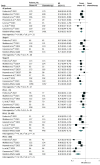Neoadjuvant Chemoimmunotherapy for NSCLC: A Systematic Review and Meta-Analysis
- PMID: 38512301
- PMCID: PMC10958389
- DOI: 10.1001/jamaoncol.2024.0057
Neoadjuvant Chemoimmunotherapy for NSCLC: A Systematic Review and Meta-Analysis
Abstract
Importance: To date, no meta-analyses have comprehensively assessed the association of neoadjuvant chemoimmunotherapy with clinical outcomes in non-small cell lung cancer (NSCLC) in randomized and nonrandomized settings. In addition, there exists controversy concerning the efficacy of neoadjuvant chemoimmunotherapy for patients with NSCLC with programmed cell death 1 ligand 1 (PD-L1) levels less than 1%.
Objective: To compare neoadjuvant chemoimmunotherapy with chemotherapy by adverse events and surgical, pathological, and efficacy outcomes using recently published randomized clinical trials and nonrandomized trials.
Data sources: MEDLINE and Embase were systematically searched from January 1, 2013, to October 25, 2023, for all clinical trials of neoadjuvant chemoimmunotherapy and chemotherapy that included at least 10 patients.
Study selection: Observational studies and trials reporting the use of neoadjuvant radiotherapy, including chemoradiotherapy, molecular targeted therapy, or immunotherapy monotherapy, were excluded.
Main outcomes and measures: Surgical, pathological, and efficacy end points and adverse events were pooled using a random-effects meta-analysis.
Results: Among 43 eligible trials comprising 5431 patients (4020 males [74.0%]; median age range, 55-70 years), there were 8 randomized clinical trials with 3387 patients. For randomized clinical trials, pooled overall survival (hazard ratio, 0.65; 95% CI, 0.54-0.79; I2 = 0%), event-free survival (hazard ratio, 0.59; 95% CI, 0.52-0.67; I2 = 14.9%), major pathological response (risk ratio, 3.42; 95% CI, 2.83-4.15; I2 = 31.2%), and complete pathological response (risk ratio, 5.52; 95% CI, 4.25-7.15; I2 = 27.4%) favored neoadjuvant chemoimmunotherapy over neoadjuvant chemotherapy. For patients with baseline tumor PD-L1 levels less than 1%, there was a significant benefit in event-free survival for neoadjuvant chemoimmunotherapy compared with chemotherapy (hazard ratio, 0.74; 95% CI, 0.62-0.89; I2 = 0%).
Conclusion and relevance: This study found that neoadjuvant chemoimmunotherapy was superior to neoadjuvant chemotherapy across surgical, pathological, and efficacy outcomes. These findings suggest that patients with resectable NSCLC with tumor PD-L1 levels less than 1% may have an event-free survival benefit with neoadjuvant chemoimmunotherapy.
Conflict of interest statement
Figures




Comment in
-
The Chemoimmunotherapy Revolution in Resectable NSCLC-The Times They Are A-Changin'.JAMA Oncol. 2024 May 1;10(5):569-570. doi: 10.1001/jamaoncol.2024.0043. JAMA Oncol. 2024. PMID: 38512287 No abstract available.
References
Publication types
MeSH terms
LinkOut - more resources
Full Text Sources
Medical
Research Materials

